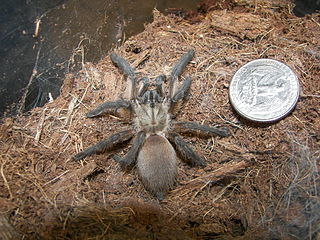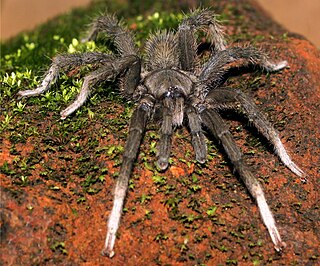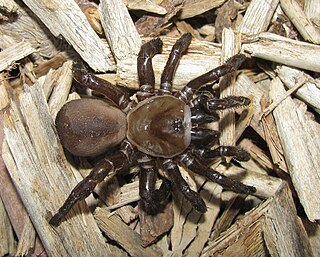
Austracantha is a genus of spider with a single species, Austracantha minax, commonly known as the jewel spider or the Christmas spider. It is a member of the family Araneidae and is endemic to Australia. They are relatively small spiders, reaching a maximum total body length of only around 12 mm (0.47 in) for females, and 5 mm (0.20 in) for males. Their abdomen has six distinctive projections ("spines") that makes them easy to identify. They are predominantly a shiny black, with variable white, yellow, and orange patterns. Melanistic forms also occur during autumn. They are facultatively gregarious, and can be found in large aggregations of overlapping orb webs. They feed on small flying insects that get entangled in their webs. They are harmless to humans, though the webs can be a nuisance for bushwalkers. They are most abundant during the summer months.

Hasora badra, the common awl, is a butterfly belonging to the family Hesperiidae, which is found in India.

Annandaliella travancorica is a species of tarantula spider found in the Western Ghats of India. It was the first of three members of the genus Annandaliella to be described, therefore the type species.

Annandaliella is a genus of tarantulas that was first described by A. S. Hirst in 1909. As of December 2019 it contains three species endemic to India: A. ernakulamensis, A. pectinifera, and A. travancorica. They are selenogyrid tarantulas, meaning they have a stridulating organ on the inner side of the chelicerae.

The Bombay caecilian is an amphibian found in India. This rather large species is found in the northern Western Ghats. The eyes are distinct and surrounded by a light ring. The tentacle is placed closer to the lip than the eye. A dark brown or greyish-brown species, it has no lateral stripes.
Neoheterophrictus uttarakannada is a species of spiders in the genus Neoheterophrictus from India. It was first described in 2012 by Manju Siliwal, Neha Gupta, & Robert John Raven. Its name comes from the place where it was discovered, Uttara Kannada.
Neoheterophrictus sahyadri is a spider species in the genus Neoheterophrictus. It was first described in 2012 by Manju Siliwal, Neha Gupta, and Robert John Raven. Its name "sahyadri" comes from the vernacular name for the Western Ghats, a mountain range in India where it was discovered.

Neoheterophrictus is a genus of tarantula in the family Theraphosidae. It comprises 8 species, all found in India.
Neoheterophrictus crurofulvus is a species of tarantula. It is also the type species of Neoheterophrictus and is found in the Western Ghats, India.

The Eumenophorinae are a subfamily of tarantula spiders. They are known from genera distributed across Sub-Saharan Africa, the south of the Arabian peninsula, Madagascar and its associated islands, and parts of India.
Neoheterophrictus amboli is a species of theraphosid spiders, which is found in India.

Neoheterophrictus smithi is a species of tarantulas, native to India.
Neoheterophrictus madraspatanus is a species of spider in the family Theraphosidae, found in India.
Plesiophrictus is a genus of tarantulas that was first described by Reginald Innes Pocock in 1899.

Euphaea cardinalis, Travancore torrent dart, is a species of damselfly in the family Euphaeidae.

Euphaea dispar, Nilgiri torrent dart, is a species of damselfly in the family Euphaeidae.

Euphaea fraseri, Malabar torrent dart, is a species of damselfly in the family Euphaeidae. This species is endemic to the Western Ghats; known to occur in various locations up to Goa.

Indosticta deccanensis, the saffron reedtail, is a damselfly species in the family Platystictidae. It is endemic to Western Ghats in India.

Halonoproctidae is a family of mygalomorph spiders, split off from the family Ctenizidae in 2018. Species in the family are widely distributed in North and Central America, Australasia, Asia, southern Europe and North Africa. One species is recorded from Venezuela in South America. They are relatively large, sombrely coloured spiders, that live in burrows with some kind of trapdoor.











